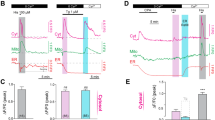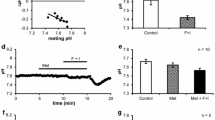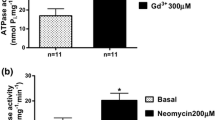Abstract
The molecular mechanism(s) involved in mediating Ca2+ entry into rat parotid acinar and other non-excitable cells is not known. In this study we have examined the kinetics of Ca2+ entry in fura-2-loaded parotid acinar cells, which were treated with thapsigargin to deplete internal Ca2+ pools (Ca2+-pool-depleted cells). The rate of Ca2+ entry was determined by measuring the initial increase in free cytosolic [Ca2+] ([Ca2+]i) in Ca2+-pool-depleted, and control (untreated), cells upon addition of various [Ca2+] to the medium. In untreated cells, a low-affinity component was detected with KCa = 3.4 ± 0.7 mM (where KCa denotes affinity for Ca2+) and Fmax = 9.8 ± 0.4 nM [Ca2+]i/s. In thapsigargin-treated cells, two Ca2+ influx components were detected with K Ca values of 152 ± 79 μM (Vmax = 5.1 ± 1.9 nM [Ca2+]is) and 2.4 ± 0.9 mM (Vmax = 37.6 ± 13.6 nM [Ca2+]is), respectively. We have also examined the effect of Ca2+ and depolarization on these two putative Ca2+ influx components. When cells were treated with thapsigargin in a Ca2+-free medium, Ca2+ influx was higher than into cells treated in a Ca2+-containing medium and, while there was a 46% increase in the Vmax of the low-affinity component (no change in KCa, the high-affinity component was not clearly detected. In depolarized Ca2+-pool-depleted cells (with 50 mM KC1 in the medium) the high-affinity component was considerably decreased while there was an apparent increase in the KCa of the low-ffinity component, without any change in the Vmax. These results demonstrate that Ca2+ influx into parotid acinar cells (1) is increased (four- to five-fold) upon internal Ca2+ pool depletion, and (2) is mediated via at least two components, with low and high affinities for Ca2+.
Similar content being viewed by others
References
Ambudkar IS, Melvin JE, Baum BJ (1988) α1,-adrenergic regulation of Cl- and Ca2+ movements in rat parotid acinar cells. Pflűgers Arch 412:75–79
Ambudkar IS, Hiramatsu Y, Lockwich T, Baum BJ (1993) Activation and regulation of calcium entry in rat parotid acinar cells. Crit Rev Oral Biol Med 4:421–425
Baum BJ, Horn VJ, Ambudkar IS (1988) Evidence that ATP- dependent Ca2+ transport in rat parotid microsomal membranes requires charge compensation. Biochem J 254:649–654
Clapham DE (1995) Calcium signalling. Cell 80:259–268
Donnadieu E, Trautmann A (1992) Calcium fluxes in T lymphocytes. J Biol Chem 267:25864–25872
Fasolato C, Hoth M, Matthews G, Penner R (1993) Ca2+ and Mn2+ influx through receptor-mediated activation of nonspecific cation channels in mast cells. Proc Natl Acad Sci USA 90:3068–3072
Fasolato C, Hoth M, Penner R (1993) Multiple mechanisms of manganese-induced quenching of fura-2 fluorescence in rat mast cells. Pflűgers Arch 423:225–231
Foskett JK, Wong DCP (1994) [Ca2+]i inhibition of Ca2+ release-activated Ca2+ influx underlies agonist-and thapsigar- gin-induced [Ca2+]i oscillations in salivary acinr cells. J Biol Chem 269:31525–31532
Hiramatsu Y, Baum BJ, Ambudkar IS (1992) Elevation of cytosolic [Ca2+] due to intracellular Ca2+ release retards carba- chol stimulation of divalent cation entry in rat arotid gland acinar cells. J Membr Biol 129:277–286
Hoth M, Penner R (1992) Depletion of intracellular calcium stores activates a calcium current in mast cells. Nature 355: 353–356
Hoth M, Penner R (1993) Calcium release-activated calcium current in rat mast cells. J Physiol (Lond) 465:359–386
Lockwich T, Mertz LM, Ambudkar IS (1993) Involvement of carboxyl groups in the divalent cation permeability of rat parotid gland basolateral plasma membrane. Mol Cell Biochem 126:143–150
Lockwich TP, Kim IH, Ambudkar IS (1994) Temperature- dependent modification of divalent cation flux in the rat parotid gland basolateral membrane. J Membr Biol 141:289–296
Marier SH, Putney JW Jr, Van De Walle CM (1978) Control of calcium channels by membrane receptors in the rat parotid gland. J Physiol (Lond) 279:141–151
Merritt JE, Rink TJ (1987) Rapid increases in cytosolic free calcium in response to muscarinic stimulation of rat parotid acinar cells. J Biol Chem 262:4958–4960
Mertz LM, Horn VJ, Baum BJ, Ambudkar IS (1990) Calcium entry in rat parotid acini activation by carbachol and aluminium fluoride. Am J Physiol 258:654–661
Mertz LM, Baum BJ, Ambudkar IS (1990) Refill status of the agonist-sensitive Ca2+ pool regulates Mn2+ influx in parotid acini. J Biol Chem 265:15010–15114
Mertz LM. Baum BJ. Ambudkar IS (1992) Membrane potential modulates divalent cation entry in rat parotid acini. J Membr Biol 126:183–193
Muallem S (1989) Calcium transport pathways of pancreatic acinar cells. Annu Rev Physiol 51:83 105
Penner R, Mattthews G, Neher B (1988) Regulation of calcium influx by second messengers in rat mast cells. Nature 334:499–504
Petersen OH. Gallacher DV (1988) Electrophysiology of pancreatic and salivary acinar cells. Annu Rev Physiol 50:65–80
Putney JW Jr (1986) Identification of cellular activation mechanisms associated with salivary secretion. Annu Rev Physiol 48:75 78
Putney JW Jr, Bird GS (1993) The inositol phosphate-calcium signalling system in nonexcitable cells. Endocr Rev 14:610 631
Takemura H. Hughes AR. Thastrup O. Putney JW Jr (1989) Activation of calcium entry by the tumor promoter thapsigargin in parotid acinar cells. J Biol Chem 264:12266 12271
Thastrup O, Cullen PJ, Drobak BK, Hanley MR, Dawson AP (1990) Thapsigargin, a tumor promoter, discharges intracellular Ca2+ stores by specific inhibition of the endoplasmic reticulum Ca2+ ATPase. Proc Natl Acad Sci USA 87:2466–2470
Toescu EC, Petersen OH (1995) Region-specific activity of the plasma membrane Ca2+ pump and delayed activation of Ca2+ entry characterize the polarized agonist-evoked Ca2+ signals in exocrine cells. J Biol Chem 270:8528–8535
Zhang GH, Melvin JE (1993) Membrane potential regulates Ca2+ uptake and inositol phosphate generation in rat sublingual mucous acini. Cell Calcium 14:551–556
Author information
Authors and Affiliations
Rights and permissions
About this article
Cite this article
Chauthaiwale, J.V., Sakai, T., Taylor, S.E. et al. Presence of two Ca2+ influx components in internal Ca2+-pool-depleted rat parotid acinar cells. Pflügers Arch — Eur J Physiol 432, 105–111 (1996). https://doi.org/10.1007/s004240050111
Received:
Accepted:
Issue Date:
DOI: https://doi.org/10.1007/s004240050111




